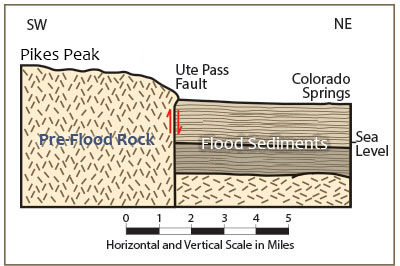Dr. Bob Visits Pikes Peak, Colorado
- Dr Bob

- Mar 28, 2023
- 4 min read
Updated: May 5, 2024
What's the story with this 14,000' mountain?
Application: Massive forces were at work in the creation of Pikes Peak.
In this L.I.F.E. Lesson, Dr. Bob visits Pikes Peak and views the massive uplift that created it, and created the Ute Pass. For additional lessons and support material, visit the A Flood of Hope site.
Supplemental Information
Towering 14,115 feet above seal level, Pikes Peak is one of the top 100 highest mountains in the United States. It is one of 53 mountains in Colorado that achieves a height of more than 14,000 feet, The air pressure at the top is about 60% of the air pressure at sea level.
This peak was formed by large reverse faults, with vertical displacements of as much as 21,000 feet. This displacement is caused by the Ute Pass Fault, a fault that is more than 40 miles in length. On the west side of the fault is Pikes Peak granite and associated Precambrian metamorphic rocks(foundation or creation rock). All the flood sediments that once sat on top of them have been removed by erosion as the great flood waters retreated.

On the east side of the Ute Pass Fault (across the valley from Pikes Peak) there are about 12,000 feet of sedimentary deposits sitting on top of the foundation rock, so the vertical displacement on the fault is about 20,000 feet. The Ute Pass Fault folded many layers of sediments from the Cambrian to Cretaceous ecosystems. These layers were placed under extreme seismic stress while they were still soft and pliable.
This folding is significant and extends for over two miles. Within three miles of the exposure of the foundation rock on the other side of the fault, the 14,000 feet of sedimentary deposits are bent into nearly vertical orientation. The Ute Pass Fault appears to be concealed deep in the foundation rock, but this thick overlying sedimentary rock above it did not fracture, and so must not have then been fully lithified. Instead, these sedimentary sdeposits were bent by vertical displacement on the Ute Pass Fault.
On the western side of the fault is Pikes Peak granite and pre-flood foundation rock, showing all sedimentary deposits (Flood rocks) having been removed by erosion (about 12,000 feet of sediment was removed by the flood waters as the hills rose up and the waters retreated).

One of the most interesting characteristics of the Ute Pass Fault is the significant folding of the layers on the eastern side of the fault. As the layers approach the flank of the Front Range, 12,000 feet of once-horizontal layers are dramatically bent into a nearly vertical orientation, as is visible in the Garden of the Gods. The sediment layers bent excessively yet did not break! It appears that at the time of uplift the sedimentary deposits adjacent to the Ute Pass Fault were not yet solidified—they were still soft. This confirms their origin in the global flood. The pressures placed on them while they were still soft further demonstrates that these layers of sediment, containing fossils from multiple ecosystems, were not deposited over millions of years, but in the same event, within a short period of time.
Pikes Peak also provides echoes of the flood narrative. As a prominent geological feature, it is easy to see how it would become a local replacement for the mountains of Ararat. The Arapaho tribe of Wyoming and Colorado share their sacred tradition of the flood, which mentions the sending of a dove to search for land. “After a while, the dove returned and reported that the waters were over all things.” They also tell of the construction of a boat and the confounding of languages that took place after the flood. The Ute version of the flood story tells how this boat landed on Pikes Peak (they called the mountain Tavá). The association of Pikes Peak with the Biblical flood story is another confirmation of the universal nature of the flood event and the lesson it shared with all of Noah's descendants.
Scripture References
"And, behold, I, even I, do bring a flood of waters upon the earth, to destroy all flesh, wherein [is] the breath of life, from under heaven; [and] every thing that [is] in the earth shall die." Genesis 6:17
"You deserted the Rock, who fathered you; you forgot the God who gave you birth." Deuteronomy 32:18
"But God remembered Noah and all the beasts and all the livestock that were with him in the ark. And God made a wind blow over the earth, and the waters subsided. The fountains of the deep and the windows of the heavens were closed, the rain from the heavens was restrained, and the waters receded from the earth continually." Genesis 8:1-3
"Oh that my words were written! Oh that they were inscribed in a book! That with an iron stylus and lead they were engraved in the rock forever!" Job 19:23-24
"Who can stand before His indignation? Who can endure the burning of His anger? His wrath is poured out like fire and the rocks are broken up by Him." Nahum 1:6
Related Information
Dr. Bob also visited the nearby Garden of the Gods.
The geology of "Garden of the Gods" tells an amazing story:




Comments